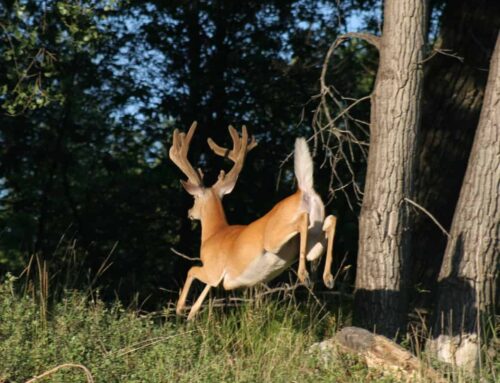 Pour a measured charge of Pyrodex down the bore, or drop in the proper number of 50-grain Triple 7 pellets. Insert bullet and start it down the bore with a short starter. With your ramrod, seat the bullet firmly all way down and on top of the powder, but don’t tamp it or beat it hard. You just want a good, firm seat.
Pour a measured charge of Pyrodex down the bore, or drop in the proper number of 50-grain Triple 7 pellets. Insert bullet and start it down the bore with a short starter. With your ramrod, seat the bullet firmly all way down and on top of the powder, but don’t tamp it or beat it hard. You just want a good, firm seat.
- Once fully loaded, leave the ramrod in the barrel and scratch it with a knife or mark with a Sharpie. Check the reference mark each time you load to make sure you seat the proper amount of powder and a bullet.
- Never cap a loaded rifle until you are in the timber and ready to hunt. When using a tree stand, climb up, secure your harness, sit down and rope up your rifle (muzzle down). Only then should you prime it or lock it. Always remove a primer, cap or disc before roping your rifle down to the ground.
- Keep spare ignition primers or caps at your fingertips (I stash several in my jacket pocket). If a dreaded misfire occurs, which is much rarer with a modern muzzleloader than it was black-powder rifles 20 years ago, stay cool and re-cap your rifle quickly and with as little movement as possible. The “pop” will startle a buck, but he might just stand there or walk slowly away. You might yet be able to touch off a kill shot.
- In the hands of a good shooter, a scoped, .50-caliber in-line with 100 to 150 grains of powder is capable of dropping a whitetail out to 150 yards or farther. But to me, even the most advanced muzzleloader is a relatively short-range arm. Try to hang stands or still-hunt where shots at bucks will be 100 yards or less.
- Always reload after shooting a buck, even if you see him lying motionless, and be ready for a follow-up shot.
- It’s strange. After shooting a buck with a saboted bullet, sometimes you’ll find only cut hair and little or no blood at the point of impact. But never think you just grazed a deer! Track a buck in the direction he fled. Fifty to 100 yards out you’re apt to pick up a blood trail that leads to your deer a few more yards away.





